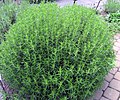Winter Savory
| Satureja montana subsp. var. | Winter savory | |||||||||||||||||||||||||||||||||||||||||||||||||||||||
|---|---|---|---|---|---|---|---|---|---|---|---|---|---|---|---|---|---|---|---|---|---|---|---|---|---|---|---|---|---|---|---|---|---|---|---|---|---|---|---|---|---|---|---|---|---|---|---|---|---|---|---|---|---|---|---|---|

|
|
| ||||||||||||||||||||||||||||||||||||||||||||||||||||||
| ||||||||||||||||||||||||||||||||||||||||||||||||||||||||
Winter savory (Satureja montana) is a perennial herb in the family Lamiaceae, native to warm temperate regions of southern Europe.wp
It is a semi-evergreen, semi-woody subshrub growing to over 230 cm ft tall. The leaves are opposite, oval-lanceolate, 1-2 cm long and 5 mm broad. The flowers are white.wp
Easy to grow, it makes an attractive border plant for any culinary herb garden.wp
An evergreen Shrub growing to 0.4m by 0.3m.pf
It is hardy to zone 6 and is not frost tender. It is in leaf all year, in flower from July to October, and the seeds ripen from August to October. The flowers are hermaphrodite (have both male and female organs) and are pollinated by Insects. It is noted for attracting wildlife.pf
Cultivation
It requires six hours of sun a day in soil that drains well.wp
The plant prefers light (sandy) and medium (loamy) soils, requires well-drained soil and can grow in nutritionally poor soil. The plant prefers acid, neutral and basic (alkaline) soils and can grow in very alkaline soil. It cannot grow in the shade. It requires dry or moist soil and can tolerate drought.pf
An easily grown plant when given suitable conditions, it prefers a well-drained poor stony soil[4, 14, 27, 52] and succeeds in a hot dry sunny position[200]. It prefers an alkaline soil[200] though it is not too fussy. It is very intolerant of soils that remain damp, especially in the winter, and dislikes shade[200]. Plants are less hardy when they are grown in rich soils and also in wet conditions[4, K]. Winter savory is often grown in the garden as a culinary herb, there are some named varieties[183]. The flavour is said to be more coarse than that of the annual savory (S. hortensis). The plants live for several years, but as they grow older they do not make so much new growth and so are best replaced every two years[4]. A good bee plant[200]. The leaves have an aromatic fragrance[245]. A good companion plant to grow in the garden, it does especially well with onions and beans and helps to repel insect pests[201]. The plant is said to inhibit the germination of certain seeds[18]. Winter savory seeds can prevent the germination of nearby seeds[201]. Members of this genus are rarely if ever troubled by browsing deer[233].pf
Propagation
Seed - surface sow in April in a greenhouse. Do not allow the compost to dry out. Germination can be slow and erratic[1] but usually takes place within a month[K]. Prick out the seedlings into individual pots as soon as they are large enough to handle. It is usually possible to plant out into their permanent positions during the summer, but if the plants have not grown sufficiently, or if you live in an area of cold winters, it might be best to grow them on in a cold frame for their first winter and plant them out in late spring or early summer of the following year[K]. Cuttings of half-ripe wood, 5 - 8cm taken at a node, July/August in a frame. Pot up in autumn and overwinter in a frame, planting out in late spring or early summer of the following year. A high percentage usually succeed[78]. Cuttings of young wood, preferably with a heel, April/May in a frame[1, 37]. Plant out in the summer if the plants grow well, otherwise overwinter them in a cold frame and plant out in late spring or early summer of the following year[K]. Division in early spring as growth commences[78, 200]. This works best if soil has been mounded up into the bottom 20cm of the plant early in the previous summer[78]. Pot up the divisions and grow them on in a cold frame until they are established. Plant them out in the summer.
Pests and diseases
Varieties
Gallery
References
- Plants for a Future - creative commons text incorporated
External links
- w:Winter Savory. Some of the material on this page may be from Wikipedia, under the Creative Commons license.
- Winter Savory QR Code (Size 50, 100, 200, 500)


